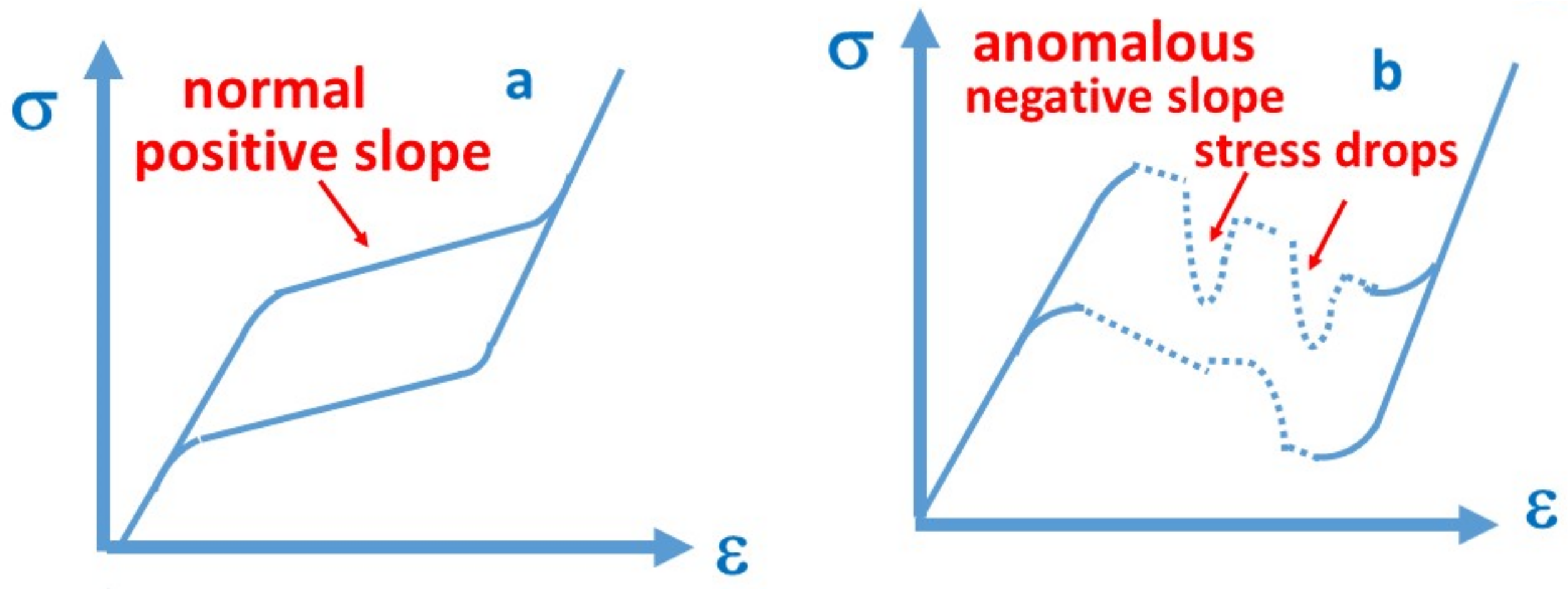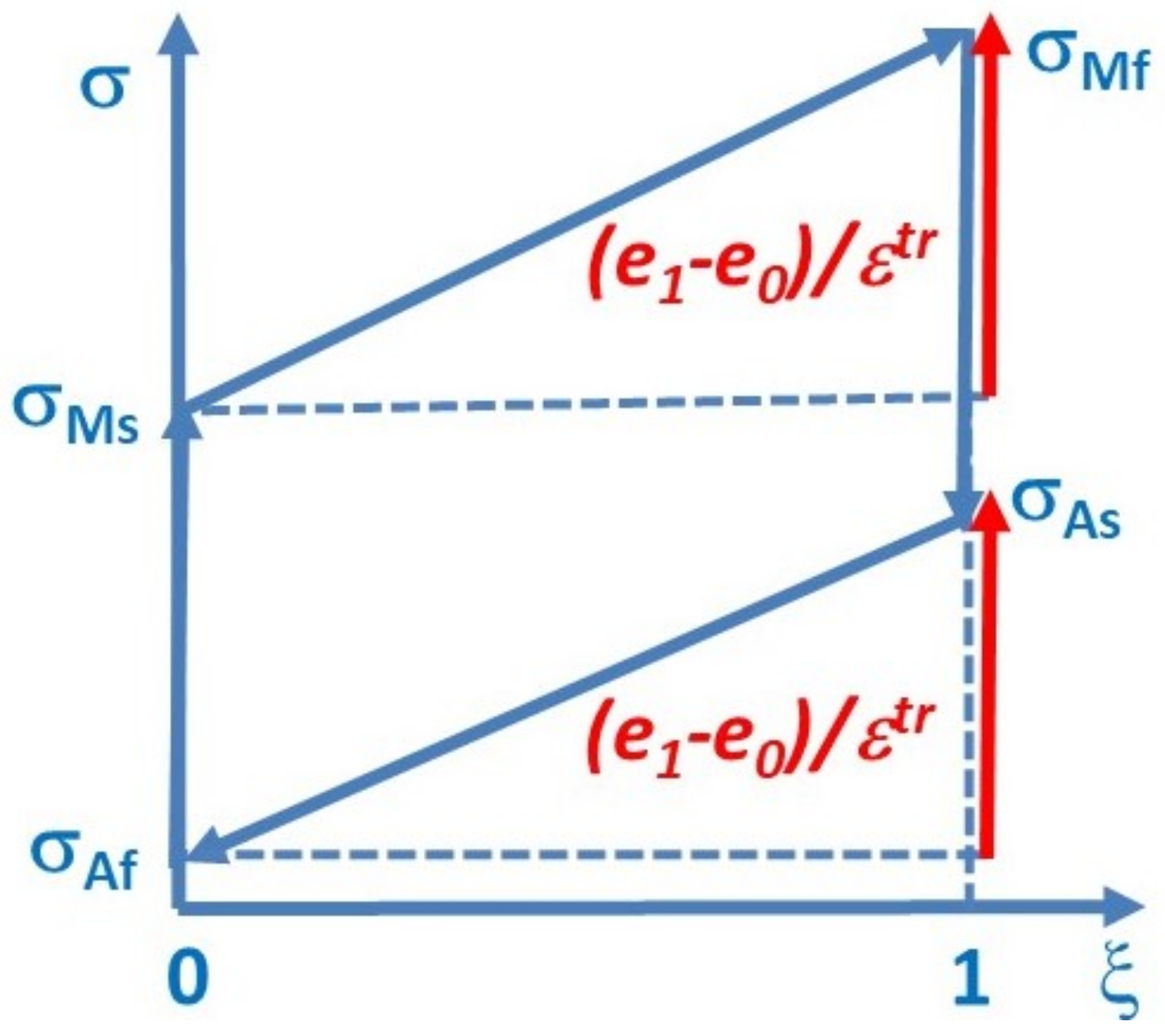Thermodynamic Analysis of Anomalous Shape of Stress–Strain Curves for Shape Memory Alloys
Abstract
1. Introduction
2. Model Calculations
2.1. The Local Equilibrium Formalism
2.2. Expressions for the Functions
3. Discussion
3.1. Expressions for the Widths of Transformations—Investigation of the Stability during Phase Transformation
3.1.1. Meaning of the Elastic and Dissipative Terms
3.1.2. Stress–Strain Loops
3.1.3. Thermal Hysteresis Loops
3.2. Growth of Two Martensite Modifications
3.3. Nucleation Difficulties
3.4. About the Burst-like Recovery
4. Conclusions
Author Contributions
Funding
Data Availability Statement
Conflicts of Interest
References
- Nikolaev, V.; Malygin, G.; Averkin, A.; Stepanov, S.; Zograf, G. Anomalous stress-strain behaviour in Ni49Fe18Ga27Co6 crystals compressed along [110]. Mater. Today Proc. 2017, 4, 4807–4813. [Google Scholar] [CrossRef]
- Nikolaev, V.; Stepanov, S.; Yakushev, P.; Krymov, V.; Kustov, S. Burst-like shape recovery and caloric effects in Ni–Fe–Ga–Co single crystalline shape memory alloys. Intermetallics 2020, 119, 106709. [Google Scholar] [CrossRef]
- Malygin, G.A.; Nikolaev, V.I.; Krymov, V.M.; Pul’Nev, S.A.; Stepanov, S.I. Interfacial Stresses and Anomalous Shape of Pseudoelastic Deformation Curves in Ni49Fe18Ga27Co6 Alloy Crystals Compressed along the [011]A Axis. Tech. Phys. 2019, 64, 819–827. [Google Scholar] [CrossRef]
- Nikolaev, V.I.; Yakushev, P.N.; Malygin, G.A.; Averkin, A.I.; Pulnev, S.A.; Zograf, G.; Kustov, S.B.; Chumlyakov, Y.I. Influence of partial shape memory deformation on the burst character of its recovery in heated Ni–Fe–Ga–Co alloy crystals. Tech. Phys. Lett. 2016, 42, 399–402. [Google Scholar] [CrossRef]
- Yang, S.; Omori, T.; Wang, C.; Liu, Y.; Nagasako, M.; Ruan, J.; Kainuma, H.; Ishida, K.; Liu, X. A jumping shape memory alloy under heat. Sci. Rep. 2016, 6, 21754. [Google Scholar] [CrossRef] [PubMed]
- Zhao, D.; Xiao, F.; Nie, Z.; Cong, D.; Sun, W.; Liu, J. Burst-like superelasticity and elastocaloric effect in [011] oriented Ni50Fe19Ga27Co4 single crystals. Scr. Mater. 2018, 149, 6–10. [Google Scholar] [CrossRef]
- Picornell, C.; Pons, J.; Cesari, E. Stress–temperature relationship in Cu–Al–Ni single crystals in compression mode. Mater. Sci. Eng. A 2004, 378, 222–226. [Google Scholar] [CrossRef]
- Picornell, C.; Pons, J.; Cesari, E. Stress-Temperature Relationship in Compression Mode in Cu-Al-Ni Shape Memory Alloys. Mater. Trans. 2004, 45, 1679–1683. [Google Scholar] [CrossRef]
- Lazpita, P.; Villa, E.; Villa, F.; Chernenko, V. Temperature Dependent Stress–Strain Behavior and Martensite Stabilization in Magnetic Shape Memory Ni51.1Fe16.4Ga26.3Co6.2 Single Crystal. Metals 2021, 11, 920. [Google Scholar] [CrossRef]
- Nikolaev, V.I.; Yakushev, P.N.; Malygin, G.A.; Pul’nev, S.A. Burst character of thermoelastic shape memory deformation in ferromagnetic Ni-Fe-Ga-Co alloy. Tech. Phys. Lett. 2010, 36, 914–917. [Google Scholar] [CrossRef]
- Picornell, C.; Pons, J.; Cesari, E. Stabilisation of martensite by applying compressive stress in Cu-Al-Ni single crystals. Acta Mater. 2001, 49, 4221–4230. [Google Scholar] [CrossRef]
- Niendorf, T.; Krooß, P.; Somsen, C.; Eggeler, G.; Chumlyakov, Y.I.; Maier, H.J. Martensite aging-Avenue to new high temperature shape memory alloys. Acta Mater. 2015, 89, 298–304. [Google Scholar] [CrossRef]
- Chernenko, V.A.; Pons, J.; Cesari, E.; Zasimchuk, I.K. Transformation behaviour and martensite stabilization in the ferromagnetic Co-Ni-Ga Heusler alloy. Scr. Mater. 2004, 50, 225–229. [Google Scholar] [CrossRef]
- Kadletz, P.M.; Krooß, P.; Chumlyakov, Y.I.; Gutmann, N.J.; Schmahl, W.W.; Maier, H.J.; Niendorf, T. Martensite stabilization in shape memory alloys-Experimental evidence for short-range ordering. Mater. Lett. 2015, 159, 16–19. [Google Scholar] [CrossRef]
- Panchenko, E.; Timofeeva, E.; Larchenkova, N.; Chumlyakov, Y.; Tagiltsev, A.; Maier, H.; Gerstein, G. Two-way shape memory effect under multi-cycles in [001]-oriented Ni49Fe18Ga27Co6 single crystal. Mater. Sci. Eng. A 2017, 706, 95–103. [Google Scholar] [CrossRef]
- Gerstein, G.; L’vov, V.A.; Kosogor, A.; Maier, H.J. Internal pressure as a key thermodynamic factor to obtain high-temperature superelasticity of shape memory alloys. Mater. Lett. 2018, 210, 252–254. [Google Scholar] [CrossRef]
- Panchenko, E.; Timofeeva, E.; Eftifeeva, A.; Osipovich, K.; Surikov, N.; Chumljakov, Y.; Gerstein, G.; Maier, H.J. Giant rubber-like behavior induced by martensite aging in Ni51Fe18Ga27Co4 single crystals. Scr. Mater. 2019, 162, 387–390. [Google Scholar] [CrossRef]
- Ahlers, M.; Pelegrina, J.L. Ageing of martensite: Stabilisation and ferroelasticity in Cu-based shape memory alloys. Mater. Sci. Eng. A 2003, 356, 298–315. [Google Scholar] [CrossRef]
- Ren, X.; Otsuka, K. Origin of rubber-like behaviour in metal alloys. Nature 1997, 389, 579–582. [Google Scholar] [CrossRef]
- Otsuka, K.; Ren, X. Mechanism of martensite aging effects and new aspects. Mater. Sci. Eng. A 2001, 312, 207–218. [Google Scholar] [CrossRef]
- Malygin, G.A. Diffuse martensitic transitions and the plasticity of crystals with a shape memory effect. Phys.-Uspekhi 2001, 44, 173–197. [Google Scholar] [CrossRef]
- L’Vov, V.A.; Rudenko, A.A.; Chernenko, V.A.; Cesari, E.; Pons, J.; Kanomata, T. Stress-induced Martensitic Transformation and Superelasticity of Alloys: Experiment and Theory. Mater. Trans. 2005, 46, 790–797. [Google Scholar] [CrossRef]
- L’Vov, V.; Matsishin, N.; Glavatska, N.; Matsishin, M. Thermoelastic behaviour of martensitic alloy in the vicinity of critical point in the stress–temperature phase diagram. Phase Transit. 2010, 83, 293–301. [Google Scholar] [CrossRef]
- Beke, D.L.; Daroczi, L.; Samy, N.M.; Toth, L.Z.; Bolgar, M.K. On the thermodynamic analysis of martensite stabilization treatments. Acta Mater. 2020, 200, 490–501. [Google Scholar] [CrossRef]
- Beke, D.L.; Daróczi, L.; Elrasasi, T.Y. Determination of Elastic and Dissipative Energy Contributions to Martensitic Phase Transformation in Shape Memory Alloys. In Shape Memory Alloys-Processing, Characterization and Applications; Fernandes, F.M.B., Ed.; InTech: Rijeka, Croatia, 2013; Chapter 7; pp. 167–196. ISBN 978-953-51-1084-2. [Google Scholar]
- Beke, D.L.; Daroczi, L.; Palanki, Z.; Lexcellent, C. Proceedings of the International Conference on Shape Memory and Superleastic Technologies, Tsukuba, Japan, 3–5 December 2007; Miyazaki, S., Ed.; ASM International: Materials Park, OH, USA, 2008; pp. 607–614. [Google Scholar]
- Hamilton, R.; Efstathiou, C.; Sehitoglu, H.; Chumljakov, Y. Thermal and stress-induced martensitic transformations in NiFeGa single crystals under tension and compression. Scr. Mater. 2006, 54, 465–469. [Google Scholar] [CrossRef]
- Efstathiou, C.; Sehitoglu, H.; Carroll, J.; Lambros, J.; Maier, H.J. Full-field strain evolution during intermartensitic transformations in single-crystal NiFeGa. Acta Mater. 2008, 56, 3791–3799. [Google Scholar] [CrossRef]
- Panchenko, E.Y.; Timofeeva, E.; Chumlyakov, Y.I.; Osipovich, K.; Tagiltsev, A.; Gerstein, G.; Maier, H. Compressive shape memory actuation response of stress-induced martensite aged Ni51Fe18Ga27Co4 single crystals. Mater. Sci. Eng. A 2019, 746, 448–455. [Google Scholar] [CrossRef]
- Liu, Y.; Yang, H. The concern of elasticity in stress-induced martensitic transformation in NiTi. Mater. Sci. Eng. A 1999, 260, 240–245. [Google Scholar] [CrossRef]
- Panchenko, E.; Chumlyakov, Y.; Eftifeeva, E.; Maier, H.J. Two-way shape memory effect in ferromagnetic Co35Ni35Al30 single crystals aged under stress. Scipta Mater. 2014, 90–91, 10–13. [Google Scholar] [CrossRef]
- Xi, S.; Su, Y. A phase field study ot the grain size effect on the thermomechanical behavior of polycrystalline NiTi thin film. Acta Mech. 2021, 232, 4545–4566. [Google Scholar] [CrossRef]
- Christian, J.W. Deformation of moving interfaces. Met. Mater. Trans. A 1982, 13, 509–538. [Google Scholar] [CrossRef]
- Basinski, Z.S.; Christian, J.W. Experiments on the martensitic transformation in single crystals of indium-thallium alloys. Acta Met. 1954, 2, 148–166. [Google Scholar] [CrossRef]
- Karaca, H.H.; Karaman, I.; Basaran, B.; Lagoudas, D.C.; Chumljakov, Y.I.; Maier, H.J. On the stress-assisted magnetic-field-induced phase transformation in Ni2MnGa ferromagnetic shape memory alloys. Acta Mater. 2007, 55, 4253–4269. [Google Scholar] [CrossRef]
- Delpueyo, D.; Crediac, M.; Balardraud, X.; Badulescu, C. Investigation of martensite structures in a monocrystalline Cu-Al-Be shape memory alloy with the grid method and infrared thermography. Mech. Mater. 2012, 45, 34–51. [Google Scholar] [CrossRef]
- Ball, J.M.; Koumatos, K.; Seiner, H. Nucleation of austenite in mechanically stabilized martensite by localized heating. J. Alloys Compd. 2013, 577, S37–S42. [Google Scholar] [CrossRef][Green Version]
- Tseng, L.W.; Ma, J.; Wang, S.J.; Karaman, I.; Kaya, M.; Luo, Z.P.; Chumljakov, Y.I. Superelastic response of a single crystalline FeMnAlNi shape memory alloy under tension and compression. Acta Mater. 2015, 89, 374–383. [Google Scholar] [CrossRef]
- Chumlyakov, Y.; Kireeva, I.; Kuksgauzen, I.; Kuksgauzen, D.; Niendorf, T.; Krooβ, P. Tension-compression assymmetryof the superelastic behavior of high-strength [001]-oriented FeNiCoAlNi crystals. Mater. Lett. 2021, 289, 129395. [Google Scholar] [CrossRef]
- Kamel, S.M.; Daróczi, L.; Tóth, L.Z.; Panchenko, E.; Chumljakov, Y.I.; Beke, D.L. Burst like recovery of Ni49Fe18Ga27Co6 shape memory single crystal after compressive stress-strain loading. In Proceedings of the 12th European Symposium on Martensitic Transformations, Ankara, Turkey, 5–9 September 2022; Kockar, B., Gortan, M.O., Eds.; Hacettepe University: Ankara, Turkey; pp. 88–89. [Google Scholar]
- Bolgár, M.K.; Tóth, L.Z.; Szabó, S.; Gyöngyösi, S.; Daróczi, L.; Panchenko, E.Y.; Chumlyakov, Y.I.; Beke, D.L. Thermal and acoustic noises generated by austenite/martensite transformation in NiFeGaCo single crystals. J. Alloys Compd. 2016, 658, 29–35. [Google Scholar] [CrossRef]



Publisher’s Note: MDPI stays neutral with regard to jurisdictional claims in published maps and institutional affiliations. |
© 2022 by the authors. Licensee MDPI, Basel, Switzerland. This article is an open access article distributed under the terms and conditions of the Creative Commons Attribution (CC BY) license (https://creativecommons.org/licenses/by/4.0/).
Share and Cite
Beke, D.L.; Kamel, S.M.; Daróczi, L.; Tóth, L.Z. Thermodynamic Analysis of Anomalous Shape of Stress–Strain Curves for Shape Memory Alloys. Materials 2022, 15, 9010. https://doi.org/10.3390/ma15249010
Beke DL, Kamel SM, Daróczi L, Tóth LZ. Thermodynamic Analysis of Anomalous Shape of Stress–Strain Curves for Shape Memory Alloys. Materials. 2022; 15(24):9010. https://doi.org/10.3390/ma15249010
Chicago/Turabian StyleBeke, Dezső L., Sarah M. Kamel, Lajos Daróczi, and László Z. Tóth. 2022. "Thermodynamic Analysis of Anomalous Shape of Stress–Strain Curves for Shape Memory Alloys" Materials 15, no. 24: 9010. https://doi.org/10.3390/ma15249010
APA StyleBeke, D. L., Kamel, S. M., Daróczi, L., & Tóth, L. Z. (2022). Thermodynamic Analysis of Anomalous Shape of Stress–Strain Curves for Shape Memory Alloys. Materials, 15(24), 9010. https://doi.org/10.3390/ma15249010






